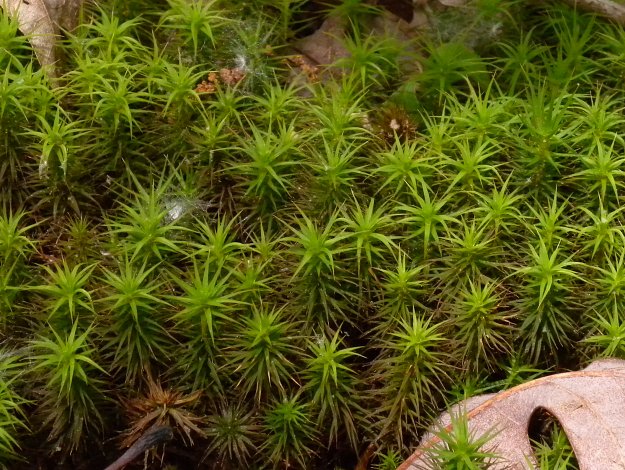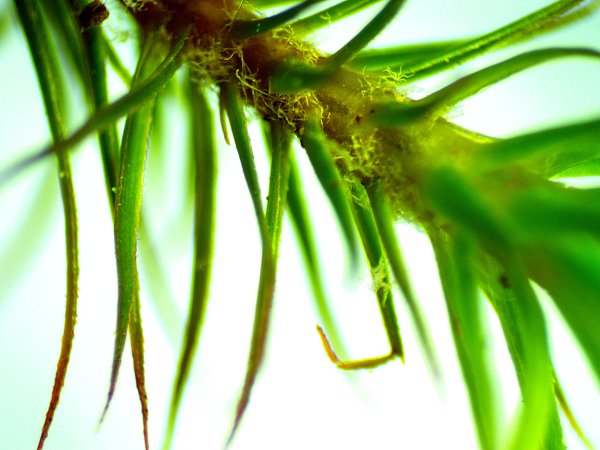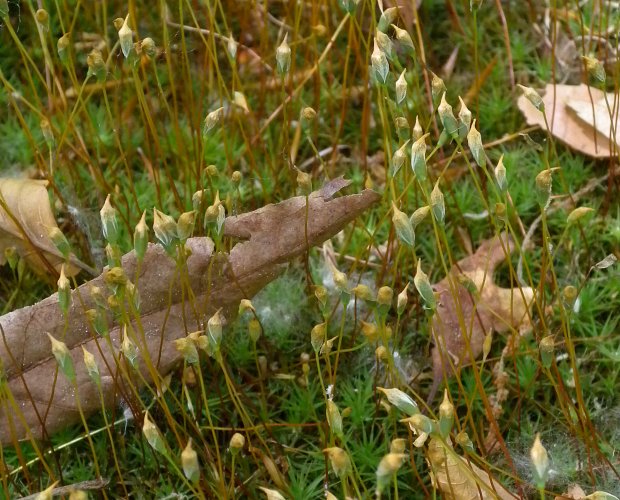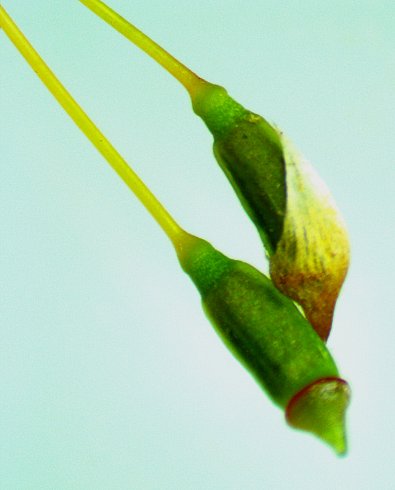
This moss is usually dioecious, producing male and female reproductive parts on separate plants. The male plants terminate in antheridial splash-cups that contain their sperm. These splash cups have triangular-shaped leafy bracts at their bases. The sperm can spread to other plants by raindrop logistics up to 1 meter away. After fertilization occurs, the female plants produce solitary sporophytes. Each sporophyte consists of a spore-bearing capsule at the apex of a long slender seta (stalk). The setae are 2-9 cm. long (at least as long as the originating plants), more or less erect, and either pale yellow, pale reddish brown, or red. The bodies of the spore-bearing capsules are held nearly erect to sideways from their setae, becoming less erect with age. These capsule bodies are 4-5 mm. long, short-cylindrical in shape, and bluntly 4-angled (becoming more angular with age), except at their bases, where they are more narrow, terete, and cup-shaped. The capsule bodies are light green while they are immature, becoming tan or brown with age.

Young capsule bodies and their lids (opercula) are covered by hairy membranous hoods (calyptrae); these hoods are long-conical or beaked. The lids of the capsule bodies have solitary conical beaks about 1 mm. long. After the lids fall off, a ring of tiny teeth is revealed. There are up to 64 of these teeth and they are early-deciduous. The upper rim is blocked by a flat plug that eventually falls away to release the spores to the wind. Individual spores are 10-13 micrometers across, globoid in shape, and relatively smooth. Individual plants are anchored to the substrate by fibrous rhizoids.
Cultivation: The preference is partial sun to light shade, mesic to dry conditions, and rocky or gravelly soil where competition from other kinds of ground vegetation is reduced. This moss is suitable for a rock garden. It remains attractive even during the winter because of its evergreen leaves.

Range & Habitat: The native Ohio Haircap Moss (Polytrichastrum ohioense) is occasional in the Shawnee Hills of southern Illinois, and uncommon elsewhere within the state (see Distribution Map). This moss is endemic primarily to eastern United States and Ontario. In Illinois, habitats include dry ground of rocky upland woodlands, areas along paths of upland woodlands, wooded hillside slopes, dry ground of thinly wooded bluff tops, rocky or sandy areas along woodland streams, sandstone ledges and cliffs, and upper slopes of wooded ravines. This moss is usually found in higher quality natural areas where there are deciduous trees, especially oaks (Quercus spp.). It often occurs with Leucobryum glaucum (Pincushion Moss), Dicranum scoparium (Windswept Broom Moss), and Cladonia rangifera (Reindeer Moss). The latter species, in spite of its common name, is actually a lichen.

Faunal Associations: Some songbirds use the persistent setae (stalks of spore-bearing capsules) of Ohio Haircap Moss and other Haircap Mosses (Polytrichum spp., Polytrichastrum spp.) as construction material for their nests. This includes such bird species as the Eastern Towhee (Pipilo erythrophthalmus), American Robin (Turdus migratorius), and Worm-eating Warbler (Helmitheros vermivorum); see Breil & Moyle (1976) and citations in Andreas (2010).
Photographic Location: An upland rocky woodland above a sandstone ravine at the Portland Arch Nature Preserve in west-central Indiana.

Comments: Another scientific name of this moss is Polytrichum ohioense and another common name of this moss is Oak Haircap Moss. Ohio Haircap Moss (Polytrichastrum ohioense) is an attractive and rather conspicuous moss. It is smaller in size than the Common Haircap Moss (Polytrichum commune), but larger in size than the Bristly Haircap Moss (Polytrichum piliferum). Ohio Haircap Moss can be readily distinguished from Juniper Haircap Moss (Polytrichum juniperinum) by the absence of teeth on the leaf margins of the latter moss. While Ohio Haircap Moss is very similar in appearance to Polytrichastrum piliferum and Polytrichastrum formosum, these latter two species have a more northern distribution in North America, where they are usually found in association with coniferous forests. In Illinois, they have been collected only once or twice as herbarium specimens. Compared to the Ohio Haircap Moss, Polytrichastrum piliferum has darker green leaves that become black with age, while the leaves of Polytrichastrum formosum tend to be more flexuous, rather than stiff and straight. For both of these mosses, the lids (opercula) on their capsule bodies are narrowly beaked, while the lids of Ohio Haircap Moss have beaks that are more conical in shape. The uppermost cells of the lamellae (green ridges above the midribs of the leaves) for these 3 species differ in size and shape. However, these distinctions can't be observed without microscopic magnification (at least 50x) of narrow cross-sections of the leaves.